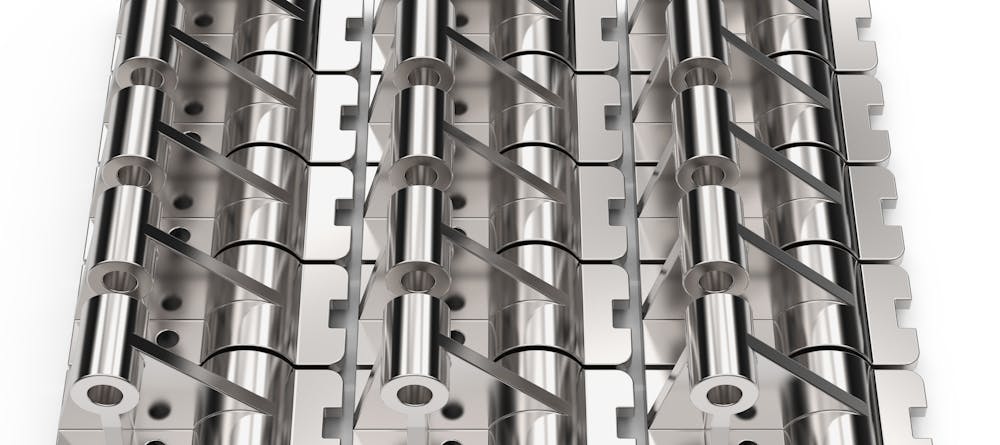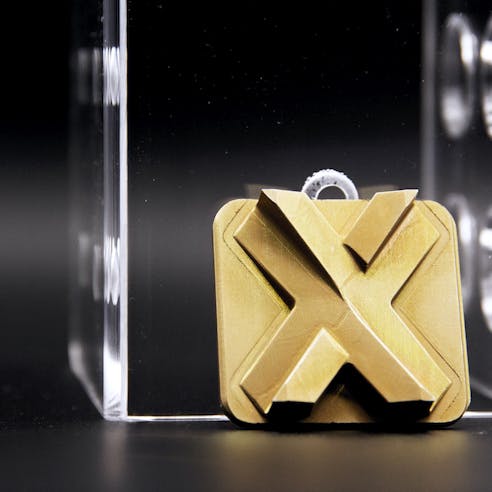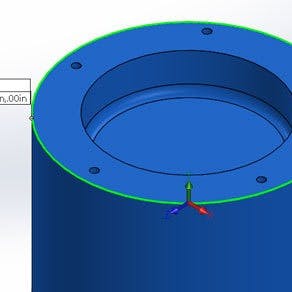Stainless Steel CNC Machining
Stainless steel is a ubiquitous metal critical to a myriad of industries from medical to power generation. Its value lies in its strength, heat resistance, and exceptional corrosion resistance. Indeed, the ability to resist corrosion is the primary thing that distinguishes stainless steel from regular steel. Choose from a wide selection of stainless steel materials for CNC machining in the Xometry Instant Quoting Engine℠.

About Stainless Steel for CNC Machining
What sets stainless steel apart from normal steel is the inclusion of chromium in its alloys. All stainless steel chemical compositions contain at least 10.5% chromium. The inclusion of chromium makes these steels more corrosion resistant. The different grades of this material have various alloying elements that serve to further improve corrosion resistance, heat treatability, and machinability. It should be noted that heat treatment can significantly affect the metal’s mechanical properties.
Stainless steels can be classified based on their crystalline structure. This includes Austenitic, ferritic, martensitic, and duplex:
- Austenitic stainless steel, such as 300- and 200-series stainless, are highly formable and do not work harden. They are also non-magnetic in an annealed condition.
- Ferritic stainless steels are magnetic and offer better thermal conductivity than austenitic stainless. They cannot be hardened by heat treatment.
- Martensitic stainless steel such as grade 416 and 420 can be hardened through multiple methods of aging or heat treatments.
- Duplex stainless steel, also known as austenitic-ferritic, are grades of stainless that are highly specialized for improved corrosion resistance. Duplex steels are typical in industrial and architectural structuring.
Given its versatility, some form of stainless steel is prevalent in every industry.
Stainless Steel 15-5
Stainless Steel 15-5 is a precipitation-hardened (PH) metal. The process gives it excellent toughness, strength, and corrosion resistance. Mechanical properties are enhanced by low-temperature heat treatment, making this material ideal for aerospace and nuclear applications.
| Tensile Strength, Yield (MPa) | Shear Modulus (GPa) | Elongation at Break (%) | Hardness (Brinell) | Density (g/cm^3) |
|---|---|---|---|---|
Tensile Strength, Yield (MPa) 1280 | Shear Modulus (GPa) 77 | Elongation at Break (%) 10 | Hardness (Brinell) 388 | Density (g/cm^3) 7.80 |
* Generalized values based on H900 condition. For reference only.
Stainless Steel 17-4
This precipitation-hardened (PH) steel grade has better corrosion-resistant properties at high temperatures when compared to 15-5 stainless steel. It achieves this increased corrosion resistance by sacrificing mechanical strength. This is also one of the more widely used grades of PH stainless steel. Applications include chemical processing parts and gas turbines.
| Tensile Strength, Yield (MPa) | Shear Modulus (GPa) | Elongation at Break (%) | Hardness (Brinell) | Density (g/cm^3) |
|---|---|---|---|---|
Tensile Strength, Yield (MPa) 1379 | Shear Modulus (GPa) 77.4 | Elongation at Break (%) 7 | Hardness (Brinell) 419 | Density (g/cm^3) 7.80 |
* Generalized values based on H900 condition. For reference only.
Stainless Steel 18-8
This grade of stainless steel has an austenitic crystal structure and is one of the most widely used grades. 18-8 is often referred to as 304 stainless steel or SS304, and Xometry quotes 18-8 as SS304, but the two have slight differences in some alloying elements. 18-8 has good corrosion resistance characteristics and is regularly used to create fasteners and pressure piping.
| Tensile Strength, Yield (MPa) | Shear Modulus (GPa) | Elongation at Break (%) | Hardness (Brinell) | Density (g/cm^3) |
|---|---|---|---|---|
Tensile Strength, Yield (MPa) 215 | Shear Modulus (GPa) 77 | Elongation at Break (%) 70 | Hardness (Brinell) 123 | Density (g/cm^3) 8.00 |
* Generalized values. For reference only.
Stainless Steel 303
This grade of austenitic stainless steel was formulated to be easier to machine than SS304 by including sulfur among the alloying elements. This addition, however, makes the alloy less corrosion resistant than SS304. It is ideal for items that require heavy machining like gears and shafts.
| Tensile Strength, Yield (MPa) | Shear Modulus (GPa) | Elongation at Break (%) | Hardness (Brinell) | Density (g/cm^3) |
|---|---|---|---|---|
Tensile Strength, Yield (MPa) 240 | Shear Modulus (GPa) 77.2 | Elongation at Break (%) 50 | Hardness (Brinell) 160 | Density (g/cm^3) 8.00 |
* Generalized values based on annealed condition. For reference only.
Stainless Steel 304
This grade of austenitic stainless steel has good corrosion resistance properties and is used extensively for fasteners. It is often seen as a low-cost alternative to SS316 while not having the same corrosion resistance. This alloy is very similar to grade 18-8 stainless steel as it has the same amount of chrome and nickel, however, it has improved strength due to a higher level of carbon in the alloy.
| Tensile Strength, Yield (MPa) | Shear Modulus (GPa) | Elongation at Break (%) | Hardness (Brinell) | Density (g/cm^3) |
|---|---|---|---|---|
Tensile Strength, Yield (MPa) 215 | Shear Modulus (GPa) 77 | Elongation at Break (%) 70 | Hardness (Brinell) 123 | Density (g/cm^3) 8.00 |
* Generalized values. For reference only.
Stainless Steel 316
This austenitic grade of stainless steel contains molybdenum which gives it excellent corrosion resistance. In addition to this, it is highly formable and weldable. Applications include chemical tanks and boat fittings. The low carbon version, 316L, is more resistant to chlorides than the basic formulation.
| Tensile Strength, Yield (MPa) | Shear Modulus (GPa) | Elongation at Break (%) | Hardness (Brinell) | Density (g/cm^3) |
|---|---|---|---|---|
Tensile Strength, Yield (MPa) 205 | Shear Modulus (GPa) 74 | Elongation at Break (%) 40 | Hardness (Brinell) 187 | Density (g/cm^3) 8.03 |
* Generalized values. For reference only.
Stainless Steel 416
Stainless steel 416 is one of the most machinable stainless steels available. As with other alloys, this improved machinability comes at the cost of corrosion resistance, so it generally rusts easier than its other stainless steel counterparts. Applications include motor shafts and gears. The raw material is typically available in a soft, easy-to-machine annealed condition (see properties below) and can be heat-treated for increased hardness and strength.
| Tensile Strength, Yield (MPa) | Shear Modulus (GPa) | Elongation at Break (%) | Hardness (Brinell) | Density (g/cm^3) |
|---|---|---|---|---|
Tensile Strength, Yield (MPa) 275 | Shear Modulus (GPa) 83 | Elongation at Break (%) 30 | Hardness (Brinell) 156 | Density (g/cm^3) 7.80 |
* Generalized values based on annealed condition. For reference only.
Stainless Steel 420
This martensitic stainless steel has a higher carbon content and lower chromium content than the other steels mentioned previously. Due to its lower chromium content, it has only mild corrosion resistance but makes up for that with improved mechanical properties in its annealed state.
| Tensile Strength, Yield (MPa) | Shear Modulus (GPa) | Elongation at Break (%) | Hardness (Brinell) | Density (g/cm^3) |
|---|---|---|---|---|
Tensile Strength, Yield (MPa) 345 | Shear Modulus (GPa) 80.7 | Elongation at Break (%) 25 | Hardness (Brinell) 195 | Density (g/cm^3) 7.80 |
* Generalized values based on annealed condition. For reference only.
Stainless Steel 440C
Stainless steel 440C has the highest carbon content of the 400 series. This means that 440C has only mild corrosion resistance. However, it has excellent hardness characteristics (which can be further increased with heat treatment) and mechanical strength. Typical applications include bearing housings and surgical instruments.
| Tensile Strength, Yield (MPa) | Shear Modulus (GPa) | Elongation at Break (%) | Hardness (Brinell) | Density (g/cm^3) |
|---|---|---|---|---|
Tensile Strength, Yield (MPa) 445 | Shear Modulus (GPa) 83.9 | Elongation at Break (%) 14 | Hardness (Brinell) 223 | Density (g/cm^3) 7.80 |
* Generalized values based on non-treated condition. For reference only.
Stainless Steel 410
Stainless steel 410 is the most general-purpose steel among the 400 series. It has a low carbon content that gives it improved corrosion resistance. Like other martensitic steels, 410 can be hardened to achieve impressive mechanical strength. 410 stainless steel is typically used for cutlery, fasteners, and machinery parts.
| Tensile Strength, Yield (MPa) | Shear Modulus (GPa) | Elongation at Break (%) | Hardness (Brinell) | Density (g/cm^3) |
|---|---|---|---|---|
Tensile Strength, Yield (MPa) 310 | Shear Modulus (GPa) 73 | Elongation at Break (%) 25 | Hardness (Brinell) 147 | Density (g/cm^3) 7.74 |
* Generalized values based on annealed condition. For reference only.
Finishes and Post-Processing Options
Xometry offers a wide range of surface finishes applicable to stainless steel.
As machined (standard): This standard finish leaves the part in its original state after machining. Xometry can achieve 125 Ra or better. Finishing passes can be performed to further refine the surface roughness. This is the most common surface finish for stainless steel.
Powder coating: Powder coating creates an excellent and robust surface finish. Stainless steel is corrosion resistant to a wide array of chemicals, but some, like chlorides, still pose a challenge. Powder coating can be used to improve its anti-corrosion properties in these situations.
Bead blasting: This process creates a smooth and uniform matte finish by lightly blasting the surface. This surface finish is generally applied for cosmetic purposes.

Cost-saving Design Tips
To reduce the cost of stainless steel alloys, below are some design tips:
Choose the right alloy: Not all stainless steels are equal in price. Make sure that the chosen material is suited to the application. These metals are generally ideal in corrosive environments but not all are resistant to the same chemicals. To learn more, contact a Xometry expert.
Machinability: Some stainless steels are more machinable than others. When only mild corrosion resistance is required, consider using free-machining stainless steel to reduce machining costs.

